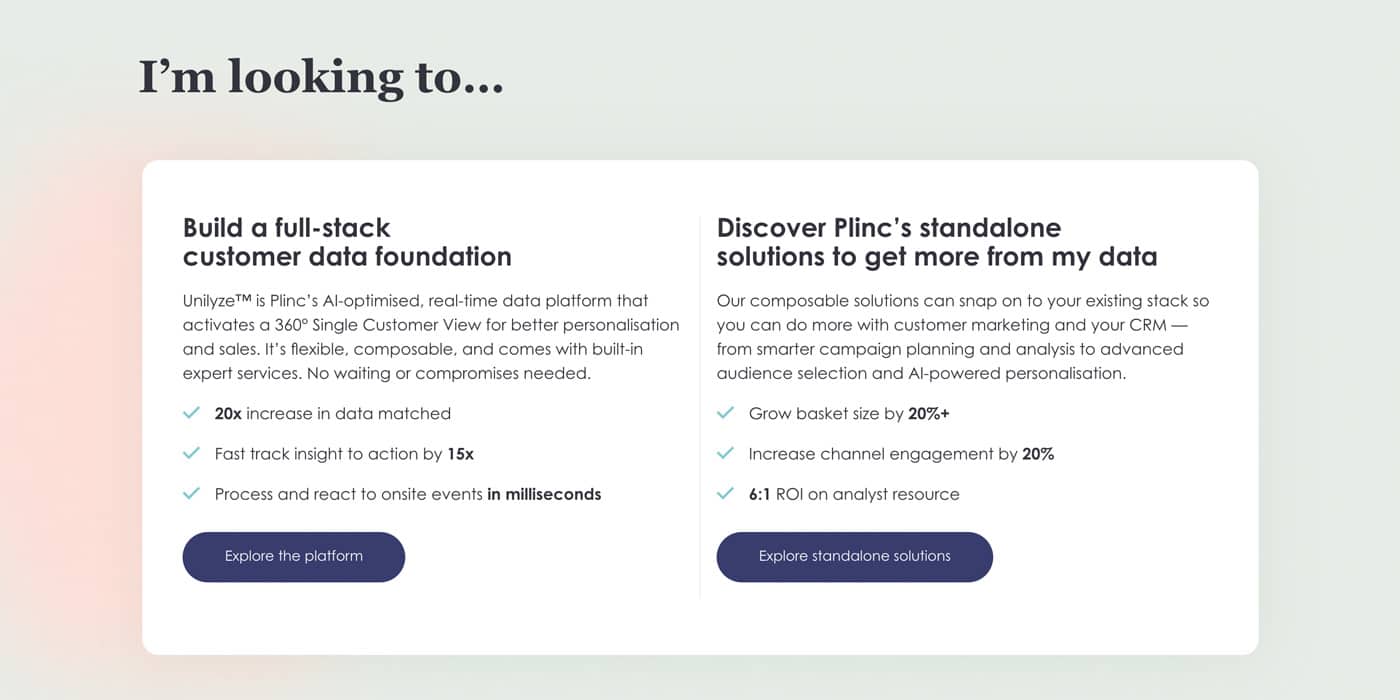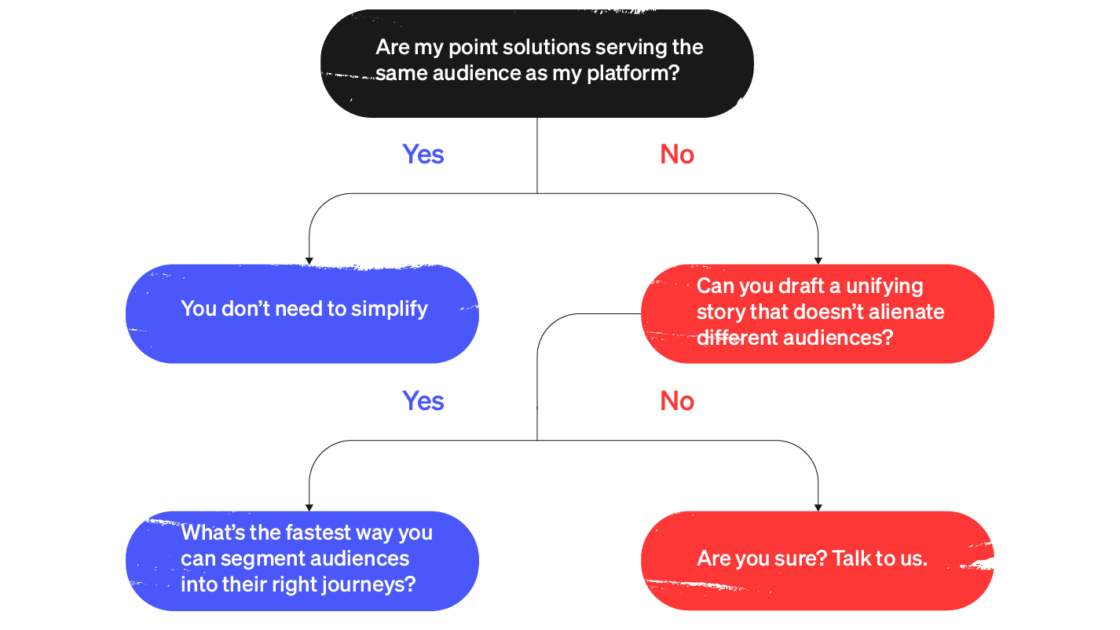So let’s say, hypothetically of course, that it’s late 2023, your revenue is down and there’s mounting pressure on you to increase sales. Just, y’know, for instance.
For complex B2B businesses, one common move is to try and make it easier for customers to buy by simplifying your offering.
But if (like so many B2B companies) you offer a mix of platform and point solutions, this problem quickly gets really hard to solve really fast. Do you consolidate? Re-prioritize? Simplify?
Every move is a double-edged sword.
- Consolidate and you risk over-bundling beyond the market’s appetite or budget
- Re-prioritize and you risk backing the wrong horse and alienating your best customers
- Oversimplify and you risk losing your mojo and actually lengthening your sales cycle
In our experience, simplification is often the shortest route to giving buyers clarity that actually accelerates sales. But it’s also the hardest to pull off — you need one clear story that wraps its arms around your platform and your point solutions and signals to customers: “the problem we solve is real, clearly defined, and we’re experts in it.”
It’s also cheaper and easier to market platforms and products within one narrative thrust than to tell a bunch of different stories on different fronts. In the same way it’s easier to serve one big client than it is ten small ones.
This blog outlines what can go wrong when companies with multiple offerings try to simplify — and then how you can get it right. Let’s go.
1. When simplification gets boring
The first thing you might want to do when consolidating your messaging is to find the common denominator that links your platform and point solutions together.
But this common denominator often risks being very over-generalized.
Say you are a company who primarily sells a CRM platform, but also has a cybersecurity module. One common denominator might be: “Streamline Operations with Maximum Efficiency.”
Sure, it sounds promising, but it’s extremely generic. It doesn’t touch upon the personalized customer management benefits of the CRM or the robust security features of the cybersecurity software. So you end up spreading all your services too thin.
Platforms and point solutions work at different altitudes. A platform is something that you build on to create a bespoke foundation, whereas point solutions are pre-made pieces of software made for specific purposes.
It’s really hard to tell one story that delivers at both altitudes without sacrificing the nuance that signals credibility, expertise and experience in the different problems you solve.
If the thing that your platform and point solutions have in common isn’t specific enough to each customer’s unique problems, any story you try to tell around it will probably be bland and unrelatable, flattening out all your best bits.
If your offering is complex, you might serve your customers (and your business) more effectively by leaning into that complexity.
2. When simplification sacrifices relevance to your ideal customers
It can be natural to lean your unifying story towards either your platform or point solutions in the name of simplicity. But both choices inevitably alienate the other half of your customer base.
Lean too hard towards your point solution use cases and you risk losing the platform champions that can turn into long-lasting and profitable relationships.
But if you lean too heavily on your platform as the big sell, it may put off larger companies looking for use-case based point solutions to fix specific problems.
Imagine you sell financial planning software that has a separate (and really popular) project management module. You might find yourself naturally angling your story to show your project management chops, and unintentionally deposition yourself as a financial platform.
But if you double down on a story for the hardcore finance audience to find high-revenue customers, it could torpedo your project management module awareness. Poof — there go your PM buyers.
Simplifying doesn’t mean picking one thing over another. It might mean creating a new thing that reframes what you do under a different umbrella.
3. When simplification slows your sales cycle
If your unifying story is too simplified, you’ll end up attracting the wrong kind of leads.
It’s like hanging up a big sign that says “We Solve Your Problems”. Prospects will wander into the wrong shop by mistake — meaning you’ll waste valuable sales time working out whether they are in the market for your solutions, and they’ll be frustrated at your lack of specificity.
The art to unifying your story without alienating anyone:
Despite its complexities, B2B decision-making is just as emotional as in B2C. A good unified story doesn’t just bring coherence to your platform and point solutions – it builds trust and confidence by signaling broader domain expertise that individual solution providers can’t match.
And this confidence counts for double right now.
When markets are up and customers are eagerly spending, a slightly dispersed narrative might go unnoticed – clients will navigate their way to your offerings.
However, in challenging times, it’s vital to concentrate your offering around a clear and pressing problem that customers are poised to invest in solving. And herein lies the true essence of unification – matching the right kind of urgency for the present context.
Here’s how to find that relevance and craft a story that’s truly compelling:
- Find something that both your audiences want. Focus on what both sets of your audiences want and need urgently. This is the foundation of your narrative — a mutual pain point or aspiration that resonates across your audience spectrum.
- Introduce a fresh spin. Create a distinct angle or perspective that not only differentiates your solutions but invites a crystal-clear choice between your platform and products.
- Highlight your unique outcomes. Move away from generic promises like “Boost revenue.” Instead, underscore the results that only YOU can bring about. So rather than stating “Sell more in every channel”, a more tailored promise could be “Personalize each touchpoint for optimized revenue across all channels.”
- Signpost your target audience. It’s essential to signal who your solution is meant for — and who it isn’t. By stating something like “Achieve personalized interactions, whether you operate with a CRM or not”, you’re clearly indicating the broad range of businesses you cater to, while subtly segmenting your audience.
Ultimately, your narrative should be sharply focused on present-day needs, uniquely anchored to what only your brand can offer, and explicitly tailored for a specified audience.
When done effectively, it doesn’t just resonate; it assures prospects of the value they’ll receive in exchange for their attention and investment.
The next step: Segmenting your audiences smoothly
If your unifying message is the first thing your customers see, the second thing should be a fork in the road – between your platform and your point solutions.
Both kinds of buyer need different things – and the sooner you can send them on a journey built to serve their specific needs, the better.
Point solutions buyers:
Larger enterprises looking for point solutions usually want to know upfront whether you integrate with their tech stack, whether you solve their specific pain point and whether they can purchase your solution separately to your platform.
So you should guide these customers to use cases, tech specs and demos for relevant point solutions.
Platform buyers:
Companies looking for a whole platform need a more considered buying journey. Committing to a platform is a big, risky and time-consuming investment — and one they don’t want to have to do again in a few years.
They need to know you’re going to keep innovating, continue to support and expand the integrations you offer, and help them stay agile for whatever comes next.
Your job is to convince them that the vision of your company aligns with these needs. The sales process will be longer, more consultative and include more stakeholders across areas like procurement, IT, executive sponsors, and more.
Putting it all together
So you’ve figured out the unifying story that houses your platform and point solutions, and mapped out the individual user journeys for each kind of buyer. How does it all fit together?
The simplest way is to lead with your unifying story on your homepage and present users with a choice to self-select down a platform path and a point solution path.
This can be as straightforward as laying the options out in front of them. For example, an option if they want to “Build their foundation from scratch” or to “Add value to your existing foundation”.
Here’ are two examples:
Fig. 1 – For Plinc, a customer data marketing platform with a bunch of cool add-on solutions.

Fig. 2 – For CID, a software development company with a popular asset and wealth management arm.

If you’re feeling more ambitious, you could also do this through creative brand awareness content.
Like when our client Salesforce needed to create two stories – one for prospects that already had a CRM platform and one for prospects who didn’t.
Prospects with a platform needed a story about Salesforce’s many add-on solutions (and we could maybe sell them the whole platform once they’d bought in.)
Prospects without a platform needed a story about the importance of having a CRM in the first place.
To segment the right prospect into the right journey, we created one of our favorite things — a grader.
Graders are survey-like experiences that benchmark users against a metric they care about (and earn a shitload of sales insights and first party data in the process). They’re great because you can also use the answers to inform future content (like “Only 24% of CMOs are happy with their average lead quality”).
In this instance, we asked leads about their CRM maturity, and recommended different next steps depending on their answers, which included recommended content and email nurture campaigns.
It was crucial to keep these journeys separate. If a lead who already has a CRM gets an email promoting content about the importance of having a CRM, at best it confuses them, but it’s much more likely to alienate them from your offering – and make them decide you’re not for them.
So, do you need a unifying story?
When the going gets tough and you urgently need more revenue it’s tempting to consolidate and simplify.
But simplification is nuanced – and the more complex your offering, the harder it is. It’s certainly not a guaranteed path to speed up the sales cycle. So before you make any sudden moves, ask yourself:


Enjoyed this article?
Take part in the discussion








Comments
There are no comments yet for this post. Why not be the first?